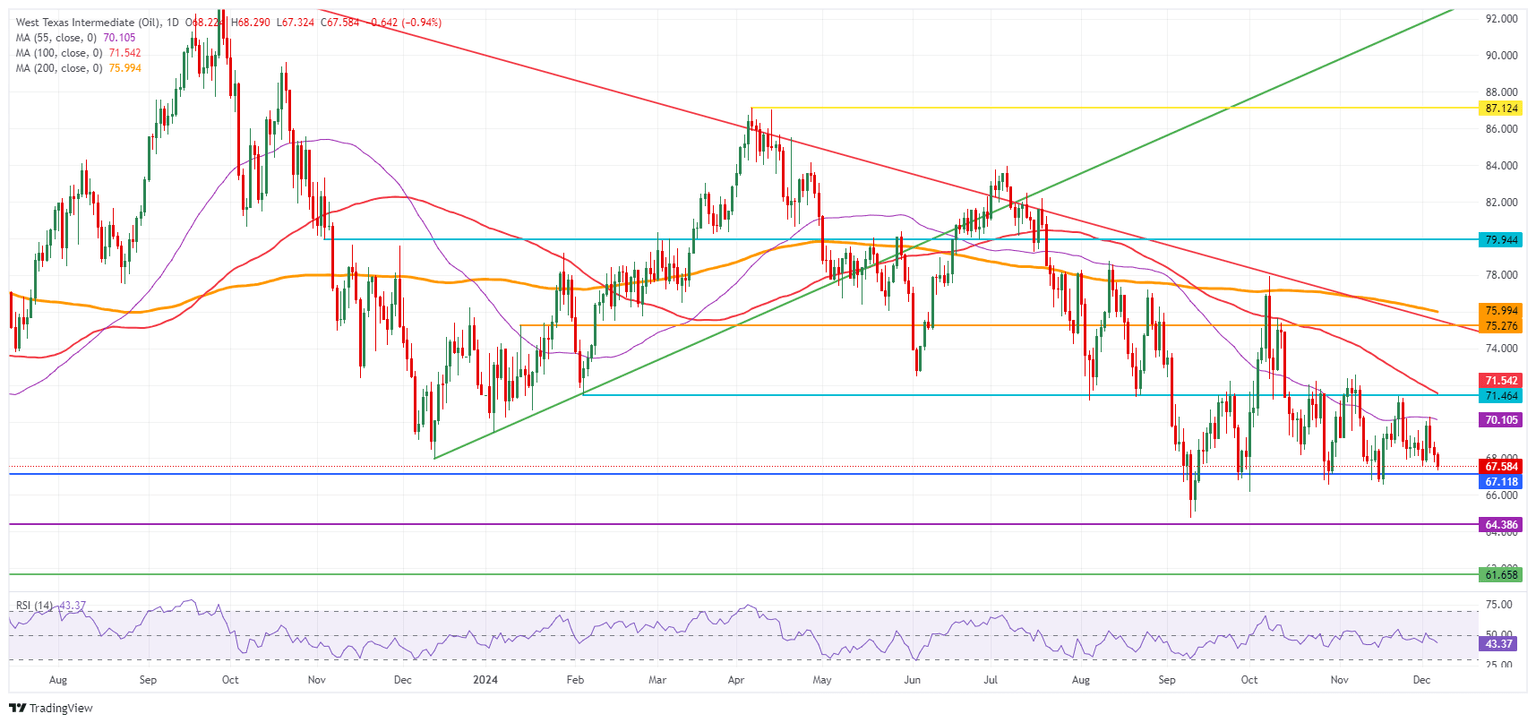Crude Oil slides more than 1% on Friday and is set to close off the week in red
- Oil prices dives lower on Friday, over 1% on the day, for a third consecutive day.
- The OPEC+ decision, which was again a three-month delay for its output normalization, does not solve the issue of oversupply.
- The US Dollar Index softens after US Nonfarm Payrolls release lands in the range of estimates.

Crude Oil slides further away from $68.00 on Friday with selling pressure persisting once OPEC+ had officially confirmed it will only delay its output normalization schedule by three months. That was the consensus view of markets, and investors took it as far too little in order to solve the current supply glut that is flooding the Oil market.
The US Dollar Index (DXY) – which measures the performance of the US Dollar (USD) against a basket of currencies – is trading softer after the US Jobs Report this Friday. The Nonfarm Payrolls print came in at 227,000, above the 200,000 estimate, but not fell out of the consensus range. The Federal Reserve (Fed) will be present as well in this Friday's economic calendar with four Fed speakers scheduled throughout the day.
At the time of writing, Crude Oil (WTI) trades at $67.35 and Brent Crude at $71.29.
Oil news and market movers: Trump will weigh
- The recent OPEC+ decision to delay a revival of supply to April will pare global Oil output next year, tightening balances somewhat, but a glut is still widely expected, according to banks and industry consultants, Bloomberg reports.
- Oil flows from Russia via the Druzhba pipeline into the Czech Republic have restarted, according to Orlen SA, a refinery operator, Bloomberg reports.
- OPEC+ pointed in its assessment to President-elect Donald Trump, who is expected to slap more sanctions on Venezuela and Iran over their Oil exports, which should resolve a portion of the oversupply.
- The weekly Baker Hughes US Oil Rig Count is due at 18:00 GMT. The expectation is for a small uptick to 478 from 477 in last week’s count.
Oil Technical Analysis: Outside events to solve oversupply
Crude Oil price looks set for more downturn with OPEC+ unable to firmly address the issue of oversupply coming from non-OPEC+ countries. President-elect Donald Trump clearly is a key element in the OPEC+ assessment as he has vowed to drill more Oil than ever and promised to issue more Oil embargoes against Venezuela and Iran. OPEC+ seems to be forgetting that one will outweigh the other, and that the current sluggish economic global growth isn’t likely to absorb the persistent oversupply.
The 55-day Simple Moving Average (SMA) at $70.11 triggered a firm rejection on Wednesday which is still playing out. Should tensions in the Middle East flare up, $71.46 with the 100-day SMA at $71.54 will act as thick resistance. In case Oil traders can plough through that level, $75.27 is up next as a pivotal level.
On the other side, traders see $67.12 – a level that held the price in May and June 2023 – as the last man standing. In case that breaks, the 2024 year-to-date low emerges at $64.75, followed by $64.38, the low from 2023.
US WTI Crude Oil: Daily Chart
WTI Oil FAQs
WTI Oil is a type of Crude Oil sold on international markets. The WTI stands for West Texas Intermediate, one of three major types including Brent and Dubai Crude. WTI is also referred to as “light” and “sweet” because of its relatively low gravity and sulfur content respectively. It is considered a high quality Oil that is easily refined. It is sourced in the United States and distributed via the Cushing hub, which is considered “The Pipeline Crossroads of the World”. It is a benchmark for the Oil market and WTI price is frequently quoted in the media.
Like all assets, supply and demand are the key drivers of WTI Oil price. As such, global growth can be a driver of increased demand and vice versa for weak global growth. Political instability, wars, and sanctions can disrupt supply and impact prices. The decisions of OPEC, a group of major Oil-producing countries, is another key driver of price. The value of the US Dollar influences the price of WTI Crude Oil, since Oil is predominantly traded in US Dollars, thus a weaker US Dollar can make Oil more affordable and vice versa.
The weekly Oil inventory reports published by the American Petroleum Institute (API) and the Energy Information Agency (EIA) impact the price of WTI Oil. Changes in inventories reflect fluctuating supply and demand. If the data shows a drop in inventories it can indicate increased demand, pushing up Oil price. Higher inventories can reflect increased supply, pushing down prices. API’s report is published every Tuesday and EIA’s the day after. Their results are usually similar, falling within 1% of each other 75% of the time. The EIA data is considered more reliable, since it is a government agency.
OPEC (Organization of the Petroleum Exporting Countries) is a group of 12 Oil-producing nations who collectively decide production quotas for member countries at twice-yearly meetings. Their decisions often impact WTI Oil prices. When OPEC decides to lower quotas, it can tighten supply, pushing up Oil prices. When OPEC increases production, it has the opposite effect. OPEC+ refers to an expanded group that includes ten extra non-OPEC members, the most notable of which is Russia.
Author

Filip Lagaart
FXStreet
Filip Lagaart is a former sales/trader with over 15 years of financial markets expertise under its belt.

















